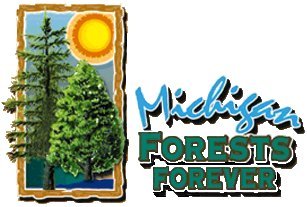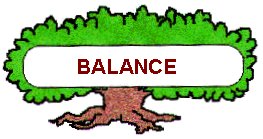

Home Page |
MICHIGAN FORESTS FOREVER TEACHERS GUIDE
| MULTIPLE USE |  |
Forests have many uses or produce many benefits to human beings. These uses and benefits are outputs. Outputs include timber, wildlife habitat, recreation opportunities, food and medicine sources, places for endangered and threatened plants and animals, clean water, healthy soils, visual quality, a source of spirituality, oxygen, temperature and humidity modification, carbon storage, and other environmental influences. Your students could probably think of many variations on these themes.
People use more forest outputs every year. There are more people each year. Without management, our forests will not be able to sustain these increasing demands. Nature, by itself, will not supply our needs in the amounts we need and when we need them. This is where the concept of balance lies, and the need for forest management. A healthy and productive forest, in an ecologically sound condition, must be sustained. This is essential to forestry . . . and to our society.
Every forest produces a wide range of benefits or multiple uses. However, the emphasis may change with forest type, location within the state, and ownership. Forest industry emphasizes timber production, but considers all outputs. A wilderness area on a national forest emphasizes recreation, spirituality, and visual quality. Many private forestowners focus on deer. How forests are managed across a large landscape will determine the overall quantity and quality of multiple uses in the big picture. Embracing this landscape concept and merging that with society's needs is a difficult task and has only become accessible with the assistance of recent technologies.
| So Many Choices! Try dividing a class into small groups of 3-4 students. Assign each group a letter or number (used later). Give each group a forest management objective (wood production, trout stream, campground, snowmobiling, plantation, rare species area, jobs in a rural town, deer habitat, etc.). Have each group develop rationale to maximize their objective and present their conclusions to the class. After the student presentations, place the group letters or numbers on display board or overhead. Examine and discuss the compatibility of adjacent uses. You can make the display board more interesting having a background of cities, roads, rivers, lakes, etc. and adding these map features to the discussion of compatibility and multiple use. |
| Activity Suggestion PLT Forests & History PLT Land Allocation 400 Acre Wood |
Controversies in Multiple Uses
Obviously, there exists a lot of room for debate on what forests should be used for. Arguments are common on the macro scale and at the stand level. Some people suggest that nature "knows" best and should not be manipulated, except to restore it a set of conditions at some arbitrary point in the past. Others may believe every acre should be intensively managed to maximize timber production. The heart of such a debate comes from opposite ends of a philosophical difference of utilitarian use versus wilderness use. Most people would understand the need for a balance somewhere in between, finding the wilderness perspective attractive and romantic but understanding that we all use forests for many purposes, some we don't even really think about.
Historically, forest management was driven by timber production and protection of forests from wildfire, insects, and diseases. Over the past few decades, timber production has remained an integral part of management but forestry has embraced a much broader set of drivers. Public land management, especially at the federal level, has been the subject of many pieces of environmental legislation and subsequent regulation.
| Definition - wilderness: "Wilderness areas" have specific definitions, mostly as federally
designated areas on federal land, as defined in the Wilderness Act of 1964.
"A wilderness, in contrast with those areas where man and his works dominate the landscape is hereby recognized as an area where the earth and its community of life are untrammeled by man, where man himself is a visitor who does not remain". The controversy is not about whether or not wilderness should exist, but more about how much and where land should be designated. Oddly enough, some wilderness areas have no more wilderness quality (at this time) than well-managed forests. Sometimes the appreciation is more in the "label" than the actual conditions. Conversely, many people regard any forested area without buildings as wilderness. This is a common misperception often promoted by tourist bureaus. The vast majority of Michigan forest continues to be impacted by humans through forest managment and timber harvest. |
| Activity Suggestion PLT Forest Consequences PLT We Can Work It Out |
To Illustrate the Polarity and the Need
A red pine plantation usually emphasizes timber production in the form of pulpwood and eventually (perhaps) in the form of utility poles and sawtimber. In younger plantations, the lack of understory and associated wildlife, due to shady conditions, has been termed a "biological desert". Older red pine plantations can be managed to take on the appearance of natural stands. Nevertheless, the characteristics of a dense red pine stand provide habitat attributes that may not occur elsewhere in the landscape. A red crossbill will do well. Animals may use the dense canopy as a temporary shelter from severe weather. There may not be a wealth of inherent habitat attributes but the few that do exist may be unique to such red pine stands, adding to community-level diversity at the landscape scale. The major benefit of such plantations is the much greater production of wood, in a much shorter period of time. Plantations interspersed with a variety of other forest types will add to landscape diversity, up to a certain point.
Large wilderness areas (see inset) protect and develop characteristics that may be missing from managed and developed areas. Large trees, a higher presence of disease, and a sense of solitude are some of the attributes of a wilderness area. They may offer insight into certain ecological processes. On the other hand, early successional forest types and associated wildlife will decline. Insect and disease outbreaks may spread beyond the wilderness borders. Most forms of popular recreation are prohibited. A landscape dominated by wilderness will usually have a negative impact on local economic activities. However, anyone who has spent time in a wilderness area that actually has the characteristics prescribed by the U.S. Congress, can't help but appreciate their value. Of course, a "sense of wildness", as described by Henry Thoreau and others, is not restricted to wilderness areas.
 |
This website was developed and created by Michigan State University Extension for the teachers of the State of Michigan. |